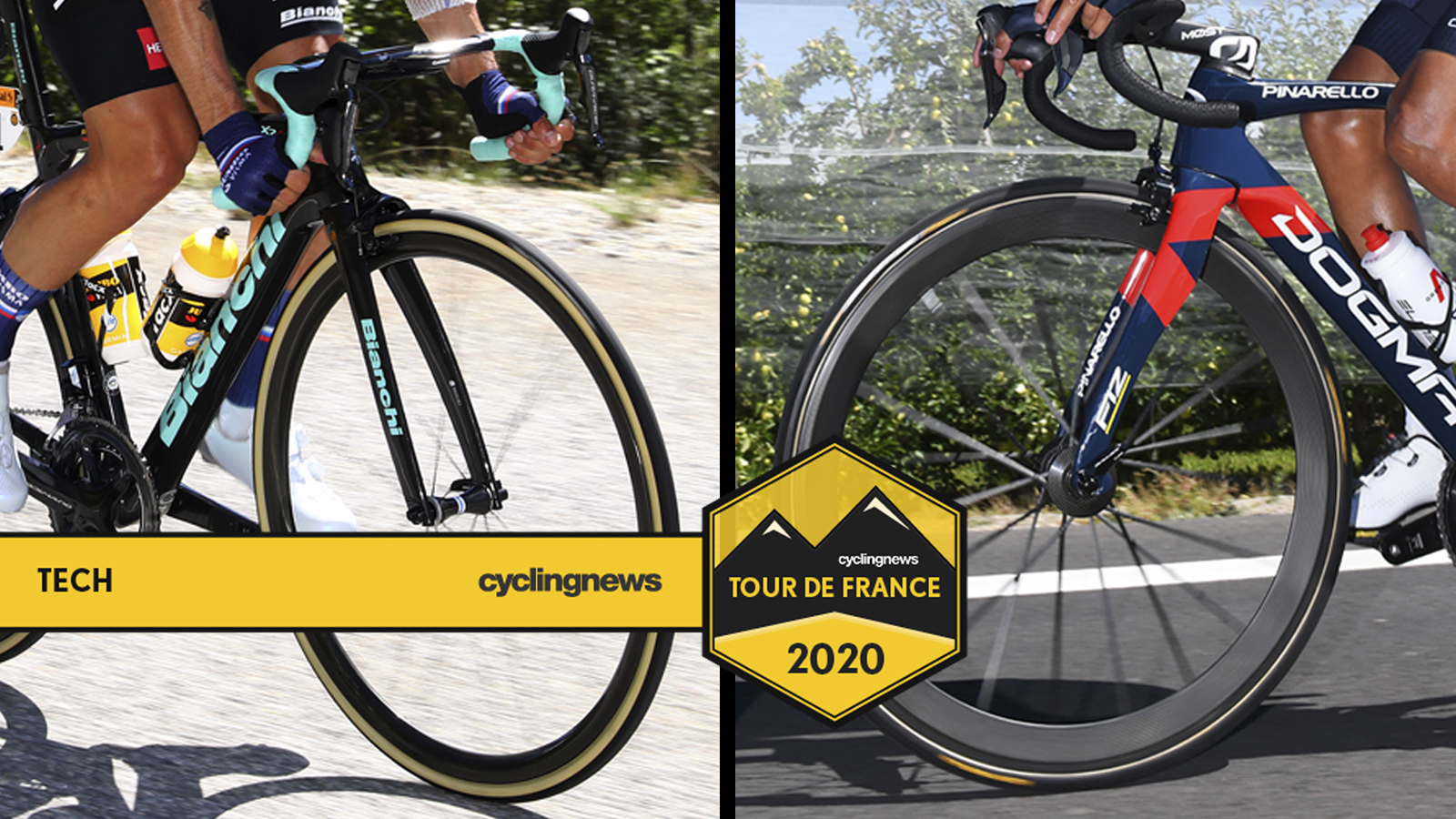Jumbo-Visma and Ineos have ditched Shimano wheels at the Tour de France but who has the lighter bike?
Unbranded Corima wheels spotted at Jumbo-Visma while Ineos Grenadiers turn to Lightweight again as the race hits the Pyrenees

First spotted at the Critérium du Dauphiné and now again at the Tour de France, Jumbo-Visma seem to have followed in the footsteps of their biggest Tour de France GC rivals, by shunning Shimano's wheels in favour of something else.
At the 2019 Tour de France, Team Ineos switched out Shimano's climbing wheels in favour of the £5,000 Meilenstein Obermayer wheels from the aptly named German outfit, Lightweight.
The astonishing price comes with an impressive weight of just 935 grams per pair. This year, Jumbo-Visma has followed suit, opting for lightweight wheels from Corima – who coincidentally sponsor Astana. They've picked out the 32mm deep WS+ tubular wheels, which weigh in at 1,270 grams per pair.
The reason for this is reasonably obvious and well-documented at this point; weight savings. And as the route enters a Pyrenean doubleheader that comprises a total of eight categorised climbs, weight will become of greater importance to the teams' respective GC leaders Primož Roglič and Egan Bernal.
Jumbo-Visma's rim-brake-equipped Bianchi Oltre XR4 frameset might be aerodynamic, but at (a claimed) 980 grams for a size 55cm frame alone, it's anything but light by today's standards. In comparison, the newly launched Trek Emonda and Specialized Tarmac both tip the scales beneath 700 grams in the same size. Despite the existence of Bianchi's lightweight Specialissima (claimed 780g for the same sized frame), the team is committed to the brand's aero road bike.
If they were to stay with their sponsors' wheels, they'd be running the C40 tubular wheels – many of the riders still are, in fact – which weigh in at 1,384 grams. By switching, the Ineos Grenadiers find themselves 449 grams to the good. Jumbo-Visma see a smaller gain, with an on-paper saving of 114 grams.
So why choose the lesser-saving offered by Corima?
Get The Leadout Newsletter
The latest race content, interviews, features, reviews and expert buying guides, direct to your inbox!
Of course, there is a limit to how low teams can go; once the bike's overall weight hits the UCI limit of 6.8kg, there's no benefit in continuing as mechanics will need to add weights back to the bike to make it legal – just as they are doing for Simon Geschke's Giant TCR. Assuming Jumbo-Visma are able to hit 6.8kg, then there's little benefit in choosing the more expensive wheels.
In addition, wheels aren't the only component on which a team can save weight. Jumbo-Visma have also been shunning the trademark celeste colour on their Bianchi bikes in favour of a new 'unique paint system'. The reason for this, again, is weight. According to Bianchi, this unique paint system is worth 80 grams compared to the traditional celeste paint, because it "reduces the molecular weight of the coating."
While most of the WorldTour bikes are now equipped with disc brakes, there's no denying that the braking technology weighs more. Thanks to a combination of the groupset itself and the added strength needed in the carbon fibre frame, disc brakes are said to add 250 - 300 grams to a bike.
Ineos Grenadiers and Jumbo-Visma are two of only three teams left in the WorldTour that are sticking with rim-brake-equipped for the Tour de France – the other is AG2R La Mondiale.
While at the Tour Down Under in January, we got hands-on with the 53cm Bianchi Oltre XR4 bike belonging to George Bennett, and the 56cm Pinarello Dogma F12 X-Light belonging to Luke Rowe. Equipped with deeper Shimano C60 tubular wheels (which weigh in at a claimed 1496 grams), Bennett's bike weighed in at 7.25kg - 450 grams above the UCI limit.
Losing 80 grams via paint, and 226 grams with the Corima wheel swap, Bennett's new weight sits at 6.94kg. Teams will often allow a little bit of leeway to account for inaccuracies of weighing scales, but we don't expect mechanics will stop there in the pursuit of the final 194 grams.
With the same Shimano C60 wheels, Luke Rowe's Pinarello Dogma F12 X-Light weighed less at 7.07kg. Bearing in mind the Ineos Grenadiers are now carrying around an all-new coat of red and blue paint as a result of their new name, we can assume that weight has increased a little, but Bernal's smaller frame will obviously weigh less from the outset. Even so, switching Rowe's wheelset out for the Lightweight Meilensteins would save 561 grams and put his frame at a UCI-illegal 6.5kg.
Based on these calculations, the Ineos Grenadiers have the upper hand on paper. But weight is only half of the power to weight equation and the Tour de France isn't won on paper, it's won on the road. As for who will come away from the weekend's GC battles better off, only the road will tell.

Josh is Associate Editor of Cyclingnews – leading our content on the best bikes, kit and the latest breaking tech stories from the pro peloton. He has been with us since the summer of 2019 and throughout that time he's covered everything from buyer's guides and deals to the latest tech news and reviews.
On the bike, Josh has been riding and racing for over 15 years. He started out racing cross country in his teens back when 26-inch wheels and triple chainsets were still mainstream, but he found favour in road racing in his early 20s, racing at a local and national level for Somerset-based Team Tor 2000. These days he rides indoors for convenience and fitness, and outdoors for fun on road, gravel, 'cross and cross-country bikes, the latter usually with his two dogs in tow.